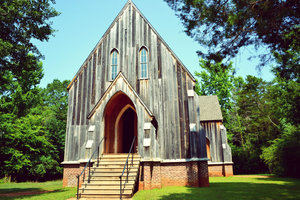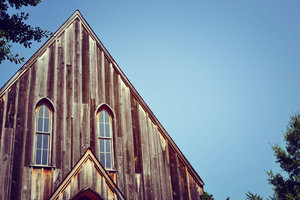Historic Church Comes Home to Old Cahawba Park
Alabama’s first state capital, Cahawba, was founded along the fertile banks of the Alabama and Cahaba Rivers in 1819. At the time, this wilderness city was home to some of America’s bravest men and women, people determined to prosper and build up a new state.

These Cahawba pioneers succeeded in constructing a grand city that lead Alabama through her early days. This was short-lived though, as the state capital designation was hastily moved to Tuscaloosa in 1826.
Nevertheless, Cahawba lived on and reached a boom period in the 1850s when a state railroad was constructed through town. The city grew and welcomed new citizens, businesses, schools and churches, including St. Luke’s Episcopal Church.
This carpenter-gothic chapel was constructed near the downtown square in 1856 and served a Cahawba congregation for about 20 years. The city took a turn for the worse after the Civil War and many citizens moved to other cities, such as Selma, Montgomery, or Demopolis. What was once a bustling city, one with importance nationally and locally, became a ghost town in a matter of years.
The St. Luke’s building escaped this fate of abandonment when it was moved to the neighboring Martin’s Station community in 1876. There it served as a sacred space for Episcopal congregations for a number of years before being a faith home for several African-American Baptist groups.
Over the years, the stately old chapel fell into disrepair on the western Alabama plains and was almost forgotten in Cahawba’s past. This was until archaeologists discovered the church’s footprint at Old Cahawba in the late 1980s as they solved many mysteries about the layout and function of the first state capital. This kick started a movement to preserve the old chapel and items and information related to it.

In a way, St. Luke’s, added to the National Register of Historic Places in 1982, became a symbol for Old Cahawba at this time. Many citizens with a mind toward historic preservation were becoming more active as the new millennium drew near and historic sites and homes were in danger of disappearing. St. Luke’s, like Cahawba, was once a central facet in some Alabamians’ lives, and there is much to gain from memories of such a place. Saving St. Luke’s became central to the future of Old Cahawba.
Fund-raising, research, and community partnerships finally led to 2002 when St. Luke’s began the journey back to its Old Cahawba home. The Alabama Historical Commission, the state agency in charge of Old Cahawba and other historic sites, purchased the St. Luke’s building and began planning its return to the original site.
Then in 2006, just weeks after the 150 anniversary of the church’s consecration, groups from Auburn University’s Rural Studio began dismantling the building and planning its reconstruction at Old Cahawba.
The chapel was successfully moved and reconstructed in all its glory at Cahawba over a two-year period. Rural Studio preserved as much of the original wood and materials as possible in the reconstruction process. They also took cues from the original 1852 Richard Upjohn architecture plans and historic photos of the church to complete the project.
Now the chapel sits near the entrance of the Old Cahawba Park and welcomes visitors with beauty and a distinguished charm. The gravel road into the park winds under moss-draped trees to Cahawba’s original Main Street and the park’s visitor center. To the left, St. Luke’s sits underneath a thicket of sighing pines looking quite content to be home.

The old church hasn’t been left to a quiet retirement. The Park hosts events and meetings inside the chapel on a regular basis. Camera-wielding visitors aim to capture the beauty of this sacred place. The church has also played host to several small wedding ceremonies and family events. The Park hopes to work with event planners in the area to offer the location for more events.
Future plans include adding plaster to the inside of the church, to historic specifications of course, and filling the interior with 19 Century pews. The Old Cahawba staff expects to have the church up to its former glory before Alabama’s bicentennial in 2019. There is no doubt that the first capital city will play a big part in the celebration, and St. Luke’s will be standing tall after all these years to help celebrate state history.
Tags: